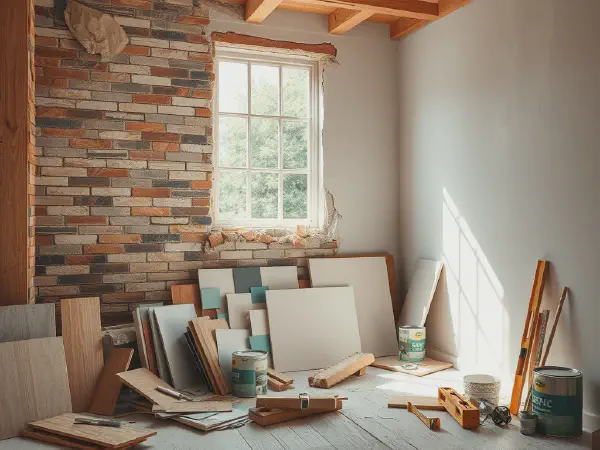Master Home Renovation Steps with This Ultimate Guide

The Ultimate Guide to Home Renovation: Transform Your Space
Home Renovation is an exciting journey that transforms your house into your dream home. It can range from simple cosmetic updates to major structural changes, all aimed at enhancing your living space. This guide covers essential aspects of home renovation to help you navigate the process smoothly.
When considering Home Renovation, it's important to identify your goals and needs. Whether you're updating an outdated kitchen, adding an extra bathroom, or enhancing your home’s curb appeal, having clear objectives will shape your renovation plan. Proper research and preparation are crucial in avoiding common pitfalls.
Planning your Home Renovation is key to a successful outcome. This includes setting a realistic budget, creating a timeline for the project, and selecting the right materials and styles. Being thorough in your planning will help minimize stress and ensure that your renovations go as envisioned.
Deciding whether to take on a Home Renovation project yourself (DIY) or hire professionals is another important consideration. There are pros and cons to both approaches, and understanding your skill level and available resources is essential in making this decision. This article will provide insight into when it's best to seek professional help versus tackling a project on your own.
The home renovation process can be broken down into detailed steps, from assessing your current space to executing renovations room by room. Understanding these steps will help you stay organized and focused throughout the renovation, leading to a timely and successful completion.
Planning Your Renovation
Setting a budget for renovation is the first step in your planning process. Determine how much you want to spend and include a contingency fund for unexpected expenses. This budget will guide your choices throughout the renovation and help you prioritize your projects effectively.
Creating a timeline for each phase of your renovation is crucial to keep the project on track. Identify key milestones and set realistic completion dates. Be sure to account for potential delays, especially if you are waiting on permits or special materials.
When it comes to choosing styles and materials for your home renovation, take inspiration from various sources such as magazines, websites, or local showrooms. Consider the existing architecture of your home to ensure that your choices enhance the overall aesthetic rather than detract from it.
DIY vs. Hiring Professionals
Deciding whether to hire a contractor or take on a DIY project can be challenging. For major renovations, complex designs, or tasks requiring specific skills, hiring professionals may be the best choice. DIY is more suitable for smaller projects if you have the necessary skills and time available.
When comparing costs between hiring professionals and doing it yourself, factor in the value of your time and the potential for errors. DIY may save money upfront, but mistakes can be costly in the long run. Getting quotes from multiple contractors can also help you understand the financial implications of hiring help.
Understanding permits and regulations is vital when renovating your home. Depending on the extent of your project, you may need permits for structural changes, electrical work, or plumbing updates. Consulting local regulations before starting can save you from legal issues and fines down the line.
Step-by-Step Renovation Process
The initial assessment of your current space involves evaluating what you want to change. Take notes on the condition of various areas, such as walls, flooring, and utilities. This assessment will inform your renovation plan and help prioritize projects based on urgency and importance.
Detailing your design planning and layout is the next step. This could involve hiring an architect or designer to create comprehensive plans. They can help ensure your vision aligns with practical considerations, including flow, function, and adherence to building codes.
Execution of renovation phases by room is the final step in the process. Working systematically can help maintain control over the timeline and budget. It’s essential to keep communication open with any hired professionals and be adaptable to changes as the project progresses.
Sourcing Materials for Renovation
Finding quality materials within your budget is crucial for a successful home renovation. Research suppliers and compare prices to find the best deals. Look for sales or clearance items, and don’t hesitate to negotiate on bulk purchases.
Sustainable options for renovation are becoming increasingly popular. Consider eco-friendly materials that enhance your home while respecting the environment. This could include reclaimed wood, low-VOC paints, or energy-efficient appliances that reduce your carbon footprint.
Local versus online purchasing options can impact your renovation experience. While online shopping offers convenience, local suppliers may provide personalized service and support. Additionally, sourcing locally can reduce shipping costs and environmental impact.
Post-Renovation Care and Maintenance
Cleaning up after renovations is essential to enjoy your new space. Take time to remove dust, debris, and leftover materials. A thorough cleanup will not only make your home look great but also ensure it is safe and ready for use.
Preventive maintenance tips for new installations can help prolong the life of your renovations. Create a maintenance schedule for items like HVAC systems, plumbing fixtures, and appliances to avoid costly repairs down the road.
To assess the quality of workmanship, regularly check the finished work and ensure it meets your expectations. If you hired professionals, don't hesitate to ask questions or request adjustments if something doesn’t meet your standards.
